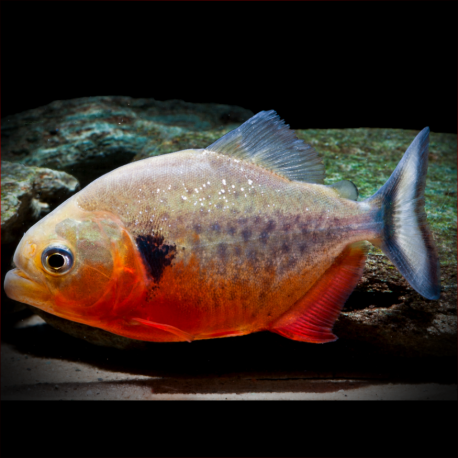More info
Datasheet
| Minimum Tank Size | 1250 litres / 330.22 US gallons |
| Maximum Size | 35.0cm / 13.78inches |
| Temperature | 20°C / 68.00°F - 28°C / 82.40°F |
| Hardness | 1.01dgH / 18ppm - 10.03dgH / 179ppm |
| pH | 4.0-7.0 |
General Description
Pygocentrus cariba, commonly known as the Black Spot Piranha, is a species within the Serrasalmidae family of the Characiformes order. These fish are characterized by their compressed body shape, long dorsal fin with 16 or more rays, and sharp serrae formed by modified abdominal scales on the ventral surface. They are native to the Río Orinoco basin in Colombia and Venezuela, predominantly found in acidic, mineral-poor blackwater environments with tannin-stained water. These predators are opportunistic generalists, known for their sharp, triangular teeth used for puncturing, tearing, chopping, and crushing various prey items.
Aquarium Setup
For a Pygocentrus cariba aquarium setup, a minimum tank size of 1250 litres is recommended. While some aquarists opt for bare-bottom tanks for maintenance ease, gravel or sand substrates work well too. Plants may be eaten, especially during spawning periods, so decorations should be chosen carefully. Lighting preferences are flexible, and efficient filtration, such as oversized external filters, is crucial due to the species' waste production. Water changes of 30-50% weekly are advised, with caution during maintenance activities to avoid startling the fish.
Behaviour
These piranhas are best kept alone, as they may prey on smaller fish, especially if hungry. In larger tanks with similarly-sized species, aggressive behavior may be observed, with fins potentially seen as food. While juveniles may group together, older individuals form loose aggregations and establish dominance hierarchies. It is recommended to keep single specimens or a group of 5-6+ together to prevent aggression, with the latter option being preferable.
Feeding and Diet
Pygocentrus cariba, though not exclusive carnivores, primarily feed on live fish, aquatic invertebrates, insects, nuts, seeds, and fruits in the wild. In captivity, juveniles can be fed bloodworms, small worms, prawns, and similar prey items, while adults accept fish flesh, prawns, mussels, and larger worms. Avoid feeding mammalian or avian meat, as the fish struggle to metabolize certain lipids, leading to health issues. The use of live feeder fish is discouraged due to disease risks unless properly conditioned.
Reproduction & Dimorphism
The reproductive behavior of Pygocentrus cariba remains unrecorded, but it likely follows a strategy similar to their congener P. nattereri. In the wild, they may have two annual reproductive seasons coinciding with water level changes during wet and dry periods. Female caribas typically grow larger than males, and sexually mature individuals exhibit a more-rounded body shape, particularly noticeable during breeding periods.
Habitat and Distribution
Black Spot Piranhas inhabit various water bodies within the Río Orinoco basin, including tributaries like ríos Inírida, Guaviare, Meta, Vichada, and others. They are commonly found in blackwater environments with tannin-stained water, though they can adapt to clearer waters. The species thrives in the extensive tropical llanos of Venezuela and Colombia, characterized by grasslands, flooded plains, and forests, with distinct wet and dry seasons and constant high temperatures.

